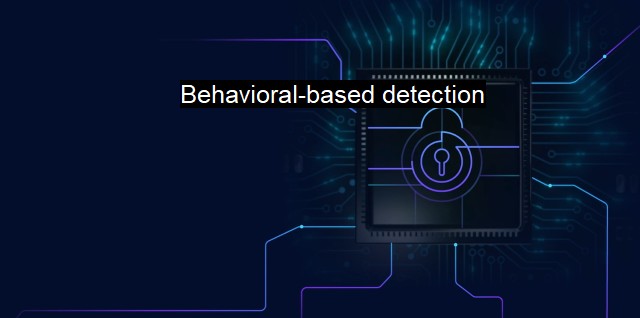What is Behavioral-based detection?
Staying Ahead of Cyber Threats: Advancements in Machine Learning and Behavioral-Based Detection for Multi-Layered Protection in Cybersecurity Networks
Behavioral-based detection is a relatively recent development in the field of cybersecurity and is particularly linked with antivirus/mobile security applications. It is fundamentally different from the traditional method of virus signature detection, offering different advantages and dealing with entirely novel threats.Traditional anti-virus software relies on what is called signature-based detection. This is where the antivirus software keeps a constantly updated database of characteristics of known viruses (the "signatures"), and continually checks if any file on your computer matches the criteria. While this method can catch many known viruses and malware, it does require regular updates to stay effective against new threats, of which thousands are created every day.
Introduced as an advancement to tackle newer types of threats, behavioral-based detection supplements signature detection and is designed to protect against unknown, previously unseen threats, known as 'zero-day' threats. It does not rely solely on virus signatures, understanding instead that malware tends to behave in certain identifiable ways.
This specifically involves monitoring the behavior of applications and systems within a digital environment. Based on a pre-set of rules or machine learning models, it spots anomalies or deviations from usual behaviors and blocks them as possible threats to system security. Any file or program that acts suspiciously, like trying to manipulate other files or communicate with a suspicious external server, could be identified as a possible issue.
This approach is especially effective against advanced persistent threats or APTs, polymorphic viruses, and ransomware that frequently change their signature to avoid traditional antivirus solutions. It is also practical for identifying insider threats and data exfiltration attempts that fall outside normal user behavior.
Consequently, behavioral-based detection is usually forming an integral part of modern cybersecurity solutions. Such tools perform a constant and real-time check of all the system functions, network interactions, memory usage, and file processes, learning what behavior patterns might signal unwanted activity, from phishing to malware.
Behavioral-based detection implements a method called heuristics to assess the potential risk posed by a new file or process. It checks to see whether this new element attempts to carry out operations commonly associated with harmful processes. These might include Autostart entries, Scripts that attempt to evade the typical security settings, or file attachments that seek to use macro commands that might not typically be needed.
Behavioral-based detection does have its share of challenges. False positives emerge as a major issue when the defense mechanism incorrectly identifies a safe program as a threat, causing interruptions to end users. Secondly, this approach could also miss threats with new, unrecognized behaviors. To counter these, cybersecurity tools are incorporating artificial intelligence and machine learning techniques to balance between avoidance of false positives and enhanced detection acuity.
To summarize, The value added by behavioral-based detection expands the capacities of cybersecurity and antivirus applications. the aim is to establish a dynamic defense strategy, maintaining a healthy digital environment. No system can have perfect security, but with behavioral-based detection, cybersecurity strategies now have a more robust and dynamic approach to combat the rising tide of ever-evolving threats.

Behavioral-based detection FAQs
What is behavioral-based detection in cybersecurity?
Behavioral-based detection is a technique used by antivirus software to identify and prevent cybersecurity threats by analyzing the behavior of an application or file. It looks for suspicious or malicious behavior that may indicate a threat, such as attempts to modify system settings, access sensitive data, or communicate with known malicious sites.How does behavioral-based detection differ from signature-based detection?
Signature-based detection relies on a database of known malware signatures to identify threats. Behavioral-based detection, on the other hand, does not rely on signatures but instead looks for suspicious behavior that could indicate a threat. This makes it more effective at detecting new and unknown threats that do not yet have a known signature.Can behavioral-based detection prevent all cybersecurity threats?
No, no single technique can prevent all cybersecurity threats. While behavioral-based detection is effective at identifying new and unknown threats, it may not be able to catch every threat. It is important to use a combination of different techniques, such as signature-based detection, network-based analysis, and human intelligence, to provide comprehensive cybersecurity protection.How does behavioral-based detection impact system performance?
Behavioral-based detection can impact system performance, as it requires real-time analysis of the behavior of every application and file. However, modern antivirus software is designed to minimize the impact on system performance, using techniques such as cloud-based analysis, machine learning, and selective scanning to reduce the processing power required. Overall, the impact on performance is generally minimal and outweighed by the benefits of improved threat detection.| | A | | | B | | | C | | | D | | | E | | | F | | | G | | | H | | | I | | | J | | | K | | | L | | | M | |
| | N | | | O | | | P | | | Q | | | R | | | S | | | T | | | U | | | V | | | W | | | X | | | Y | | | Z | |
| | 1 | | | 2 | | | 3 | | | 4 | | | 7 | | | 8 | | |||||||